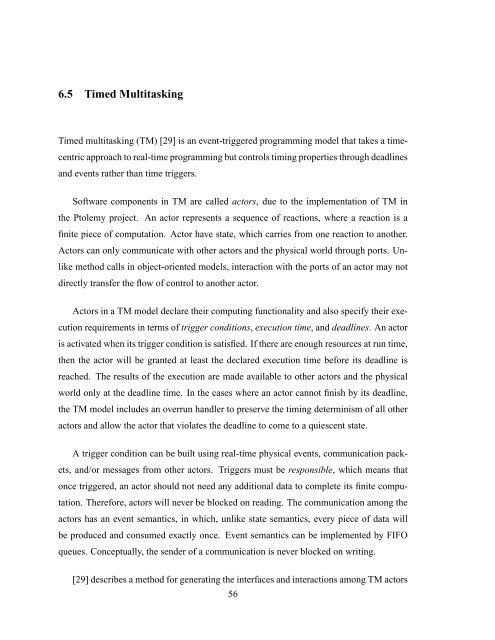Design and Implementation of TinyGALS: A Programming Model for ...
Design and Implementation of TinyGALS: A Programming Model for ...
Design and Implementation of TinyGALS: A Programming Model for ...
You also want an ePaper? Increase the reach of your titles
YUMPU automatically turns print PDFs into web optimized ePapers that Google loves.
6.5 Timed Multitasking<br />
Timed multitasking (TM) [29] is an event-triggered programming model that takes a time-<br />
centric approach to real-time programming but controls timing properties through deadlines<br />
<strong>and</strong> events rather than time triggers.<br />
S<strong>of</strong>tware components in TM are called actors, due to the implementation <strong>of</strong> TM in<br />
the Ptolemy project. An actor represents a sequence <strong>of</strong> reactions, where a reaction is a<br />
finite piece <strong>of</strong> computation. Actor have state, which carries from one reaction to another.<br />
Actors can only communicate with other actors <strong>and</strong> the physical world through ports. Un-<br />
like method calls in object-oriented models, interaction with the ports <strong>of</strong> an actor may not<br />
directly transfer the flow <strong>of</strong> control to another actor.<br />
Actors in a TM model declare their computing functionality <strong>and</strong> also specify their exe-<br />
cution requirements in terms <strong>of</strong> trigger conditions, execution time, <strong>and</strong> deadlines. An actor<br />
is activated when its trigger condition is satisfied. If there are enough resources at run time,<br />
then the actor will be granted at least the declared execution time be<strong>for</strong>e its deadline is<br />
reached. The results <strong>of</strong> the execution are made available to other actors <strong>and</strong> the physical<br />
world only at the deadline time. In the cases where an actor cannot finish by its deadline,<br />
the TM model includes an overrun h<strong>and</strong>ler to preserve the timing determinism <strong>of</strong> all other<br />
actors <strong>and</strong> allow the actor that violates the deadline to come to a quiescent state.<br />
A trigger condition can be built using real-time physical events, communication pack-<br />
ets, <strong>and</strong>/or messages from other actors. Triggers must be responsible, which means that<br />
once triggered, an actor should not need any additional data to complete its finite compu-<br />
tation. There<strong>for</strong>e, actors will never be blocked on reading. The communication among the<br />
actors has an event semantics, in which, unlike state semantics, every piece <strong>of</strong> data will<br />
be produced <strong>and</strong> consumed exactly once. Event semantics can be implemented by FIFO<br />
queues. Conceptually, the sender <strong>of</strong> a communication is never blocked on writing.<br />
[29] describes a method <strong>for</strong> generating the interfaces <strong>and</strong> interactions among TM actors<br />
56
















